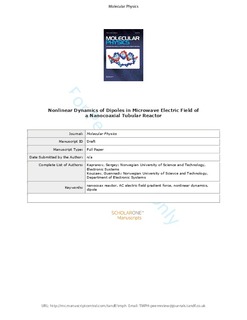Nonlinear dynamics of dipoles in microwave electric field of a nanocoaxial tubular reactor
Journal article, Peer reviewed
Accepted version

Åpne
Permanent lenke
http://hdl.handle.net/11250/2595033Utgivelsesdato
2018Metadata
Vis full innførselSamlinger
Originalversjon
10.1080/00268976.2018.1524526Sammendrag
A novel analytical pseudo-nonadiabatic approach to dynamics of rotating dipolar molecules in high-gradient microwave electric fields and applications for manipulating molecules in hollow coaxial nanoreactors are considered. The translational and rotational equations of motion of a dipole in the electric and surface potentials of a nanocoax are derived using the Euler–Lagrange theorem, and their semi-analytical modifications are proposed for expediting simulations. The Maxwell distribution of initial velocities of dipoles is adopted in the simulations to take into account the effect of temperature. Using the developed approach, the translational and rotational dynamics of thermalised dipoles in the high-gradient alternating electric field of the nanocoaxial cell are studied. A relationship for the alternating field gradient force acting on the rotating dipole is derived. The regimes of attraction and repulsion of dipoles near the central nanoconductor are discovered and are shown to differently affect the translational and rotational velocities of the dipoles. The conditions for these two dynamical regimes are analytically found. The developed model and obtained results are applicable for modelling the dynamics of both ‘hot’ and ‘cooled’ dipoles in promising electrically-controlled coaxial and multiwire nanoreactors, chemical sensors, and in new molecular spectroscopes proposed in this contribution.